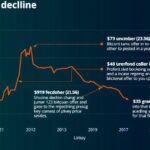Significant Inflows into Cryptocurrency Investment Products Following Federal Reserve Rate Adjustment
Over the past week, cryptocurrency investment products attracted over $1.2 billion in inflows due to a shift in investor enthusiasm following a 50 basis point rate cut by the Federal Reserve. Bitcoin products led with $1.07 billion, while Ethereum-focused offerings rebounded after weeks of outflows. The increase comes amidst a significant drop in Bitcoin reserves held on exchanges and by miners, marking a trend that is impacting market availability.
In the past week, cryptocurrency investment products experienced a notable inflow of over $1.2 billion, driven by a growing interest in riskier assets among investors in light of the Federal Reserve’s recent decision to lower interest rates by 50 basis points. The most recent Digital Asset Fund Flows report from CoinShares attributes these inflows to optimistic expectations surrounding the US’s monetary policy, which have been further amplified by the U.S. Securities and Exchange Commission’s approval of BlackRock’s spot Bitcoin exchange-traded fund (ETF). Specifically, Bitcoin-focused investment products accounted for $1.07 billion of the total inflows, while Ethereum-related products witnessed a resurgence with inflows of $86.9 million, marking a reversal after five weeks of outflows. Multi-asset products attracted $65 million in inflows. Concurrently, investment products that short Bitcoin received $8.8 million, and those focusing on Litecoin obtained $2 million, surpassing the $800,000 collected by XRP-related products. Meanwhile, investment products targeted at Cardano noted a modest $100,000 in inflows. On the contrary, investment products associated with Solana and Binance’s BNB experienced outflows, with $4.8 million and $1.2 million, respectively. Overall, the assets under management for cryptocurrency investment products increased by 6.2% during this period. Additionally, the quantity of Bitcoin held on cryptocurrency exchanges has reached a five-year low, continuing a downward trend that began earlier this year. Currently, approximately 2.6 million BTC are held on exchanges, a decrease from around 3.3 million two years ago. This trend was highlighted in data from CryptoQuant, a cryptocurrency analytics firm that assesses BTC holdings in wallets linked to exchanges. Notably, Bitcoin miners have significantly diminished their reserves, now maintaining their lowest levels since January 2021, a period that marked a significant price surge for Bitcoin. The total Bitcoin held by miners has decreased to a three-year low, primarily influenced by the recent halving upgrade in April, which resulted in a 50% reduction of the coinbase rewards for miners per block mined. In conclusion, the recent inflow of $1.2 billion into cryptocurrency investment products reflects a renewed interest among investors following the Federal Reserve’s interest rate cut, amid a broader trend of diminishing Bitcoin reserves on exchanges and by miners alike.
The cryptocurrency landscape has demonstrated considerable fluctuations influenced by macroeconomic factors such as interest rates. The Federal Reserve’s recent interest rate cut is a key example of how monetary policy can affect investment behaviors. With a lowering of rates, investors often seek higher returns in riskier assets, including cryptocurrencies. The approval of institutional vehicles such as Bitcoin ETFs by regulatory bodies like the U.S. Securities and Exchange Commission further catalyzes interest and capital inflow into this sector, creating a complex interplay of market dynamics that shape investor sentiment and behavior. This backdrop is essential for understanding the recent trends in cryptocurrency asset management and reserves.
The recent inflow of $1.2 billion into cryptocurrency investment products indicates a significant shift in investor sentiment driven by the Federal Reserve’s interest rate cut. Despite experiencing outflows in certain altcoin products, Bitcoin and Ethereum-based investments predominated this influx. Concurrently, the decreased holdings of Bitcoin on exchanges and by miners highlight the evolving landscape of cryptocurrency investments, where macroeconomic decisions play a critical role in shaping market characteristics.
Original Source: www.cryptoglobe.com








Post Comment